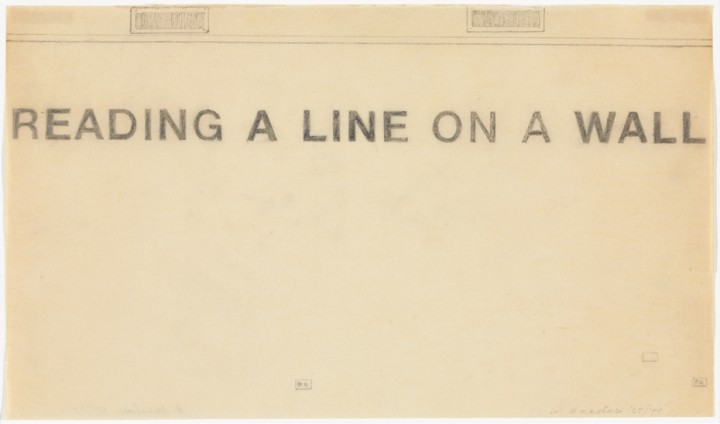
In reading the discussions so far, I’m struck by how little talk there has been about how much of the work in this exhibition functions as drawing. That’s especially interesting to me because the work comes from a collection well known for its focus on the contemporary practice of drawing. So I’d like to talk about how the drawings in Art=Text=Art both exist within traditional parameters and expand the boundaries of drawing.
In his The Elements of Drawing (1885), John Ruskin—the father of modern drawing instruction—said that one of the acceptable aims for the serious drawing student was to “be able to set down clearly, and usefully, records of such things as cannot be described in words.” What would John Ruskin, with his Victorian notions of drawing, make of the drawings in Art=Text=Art? My guess is that he’d be fairly scandalized since what he has in mind are beautifully rendered images of important architecture and sublime landscapes drawn from life or faithfully copied from a master artist’s work.
But many of the drawings here are recording “such things as cannot be described in words.” They just happen to be doing so with words. I’m thinking of work like Susanna Harwood Rubin’s 102 boulevard Haussmann and William Anastasi’s Untitled (READING A LINE ON A WALL). At first glance they may seem like dry, conceptual statements. But those statements—carefully rendered in graphite using methods not so different from the ones Ruskin espouses in The Elements of Drawing—conjure real physical spaces within in the viewer’s mind. So could they be thought of as observational? In what other ways do the drawings in Art=Text=Art exist within and expand the traditional modes of drawing?
Molly Springfield (b. 1977, Columbia, SC) earned her BA magna cum laude from Queens College, Charlotte, North Carolina (1999). She received her Post-Baccalaureate Certificate from the Maryland Institute College of Art, Baltimore (2000), and her MFA from the University of California, Berkeley (2004). She took part in the Skowhegan School of Painting and Sculpture, Skowhegan, Maine (2006). Springfield was a resident at the Millay Colony for the Arts, Austerlitz, New York (2008). She has thrice received a Visual Artist Fellowship from the D.C. Commission on Arts & Humanities / National Endowment for the Arts (2009, 2011, 2014). Recent solo exhibitions have been held at Mireille Mosler, New York (2008); Steven Wolf Fine Arts, San Francisco (2009, 2013); Thomas Robertello Gallery, Chicago (2009, 2012); and the Center Art Gallery at Calvin College, Grand Rapids, Michigan (2011). Recent group exhibitions have been held at the Portland Museum of Art, Portland, Maine (2010); the University of Buffalo Art Gallery, Center for the Arts, Buffalo, NY (2012); the Indianapolis Museum of Art (2012); Tracy Williams, Ltd., New York, NY (2013); Galerie Thomas Zander, Cologne, Germany; and The Drawing Center, New York, NY (2013). Springfield lives and works in Washington, D.C., where she is a Professorial Lecturer in the Department of Art at American University. More information about her work can be found at www.mollyspringfield.com.